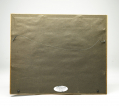site search
online catalog
THE KANAWHA VALLEY CAMPAIGN OF 1862!

$3,500.00
Quantity Available: 1
Item Code: 1266-199
Shipping: Determined by Method & Location of buyer
To Order:
Call 717-334-0347,
Fax 717-334-5016, or E-mail
The Kanawha Valley Campaign of 1862 was a Confederate effort to regain control of western Virginia region and its resources, primarily its salt mines, but also Union supply depots and possibly gain new recruits, though public sentiment was divided, as this general order would imply. The withdrawal of much of Union General Cox’s Kanawha Division to Washington in mid-August to reinforce Pope left about 5,000 Union troops there under Col. J.A.J. Lightburn and Confederate General W.W. Loring with about the same number of men moved against Lightburn a few days later. Loring, who had prewar regular army service, had joined the Confederacy and fought in the Western Virginia Campaign of 1861, but had touchy relationships with Lee and Jackson: his assignment to department command was in part a way of separating him from Jackson. Loring’s 1862 offensive included a cavalry raid that actually crossed into Ohio, several skirmishes and two battles: Fayetteville on September 10 and Charleston on September 13, which led to Lightburn’s withdrawal of his forces into Ohio and Loring’s occupation of the town, surrounding area, and abandoned Union supply depots.
The General Order, dated September 24, is clearly an effort to quiet public fears and restore confidence in the Confederate Army, Confederate currency, and the Confederate government itself. The particular issue, however, seems to have been the reluctance of businessmen to take Confederate money in payment for material purchased by the Confederate army, something perhaps also connected with divided loyalties among the citizenry, though it has been said that Union sentiment seemed to dominate in the more mountainous regions and Confederate sympathy in the valleys.
In the end, Loring’s occupation of the town only lasted about 40 days. Cox was sent back to retake the valley and Confederates had already begun to withdraw by October 9. Loring was replaced on October 15 for failure to cooperate with higher authorities, a repeated problem in his Confederate military career, and Cox advanced on October 20, reoccupying Charleston just ten days later, after it had been abandoned by Confederate forces now under Gen. John Echols, who was later defeated at Droop Mountain. Loring was transferred to the western theatre, where he purportedly also clashed with Pemberton, but it seems served well enough under Johnston, Hood, and Johnston again, even assuming corps command for a time after the death of Polk. His postwar career involved military service in Egypt, but he eventually returned to the U.S.
The order has been matted and framed. We have not examined it out of the frame, but the condition appears excellent with no folds or tears, bold, dark lettering, and just light foxing and age stains. The number of the order has not been filled in so it clearly was not a copy posted somewhere in the town and was likely captured when Union forces retook Loring’s former headquarters. [sr][ph:L]
~~~~~~~~~~~~~~~~~~~~~~~~~~~~~~~~~~~
THIS ITEM, AS WITH ALL OTHER ITEMS AVAILABLE ON OUR WEB SITE,
MAY BE PURCHASED THROUGH OUR LAYAWAY PROGRAM.
CLICK HERE FOR OUR POLICIES AND TERMS.
THANK YOU!
Inquire About THE KANAWHA VALLEY CAMPAIGN OF 1862!
For inquiries, please email us at [email protected]
Most Popular
Historical Firearms Stolen From The National Civil War Museum In Harrisburg, Pa »
Theft From Gravesite Of Gen. John Reynolds »
Selection Of Unframed Prints By Don Troiani »
Fine Condition Brass Infantry Bugle Insignia »
British Imported, Confederate Used Bayonet »
Scarce New Model 1865 Sharps Still In Percussion Near Factory New »
featured item
US MARINE CORPS OFFICER’S ENGLISH MADE MAMALUKE WITH IVORY GRIP
Manufactured: England Maker: Unmarked Year: C1820-25 Model: Mamaluke Size: 35.8 inch blade, 1.21 wide Condition: Excellent+ Tri-color blade - blue, gold and "white" of flat design. Ship's Mast, American Eagle, Standing Indian figure and… (870-76). Learn More »
site search
Upcoming Events
May 16 - 18: N-SSA Spring Nationals, Fort Shenandoah, Winchester, VA Learn More »




